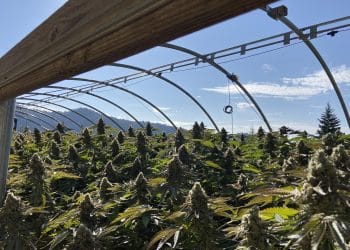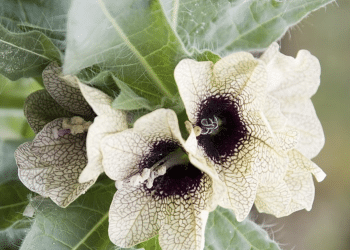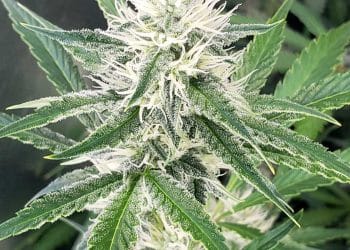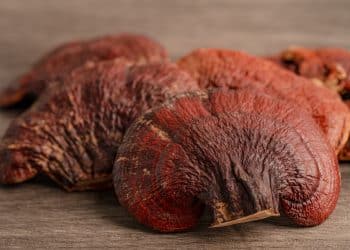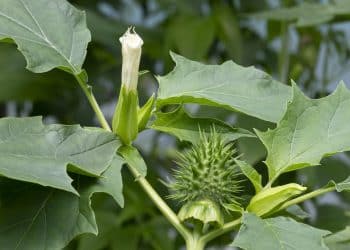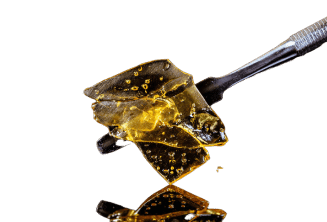From neurological disorders to digestive issues, cannabis can potentially provide an organic alternative to an industry dominated by synthetic pharmaceuticals. [1][2] As the medical community discovers more cannabinoids, the potential therapeutic effects of this plant grow as well. The biggest problem with using cannabis as a medicine is that the law tends to get in the way.
Depending on the location, cannabis may be banned outright, allowed for a limited number of medical conditions, or fully legal for all to consume. This regulatory barrier stops research from developing and prevents patients from determining the best possible treatment for themselves. But if the issue is the plant itself, then maybe the easiest solution is to get the cannabinoids from a different source.The woolly umbrella also known as Helichrysum umbraculigerum, is a fully legal plant that has the potential to produce its own cannabinoids.
What is the Woolly Umbrella?
The woolly (or wooly) umbrella is a yellow flower native to South Africa that has a velvety touch and a curry-like aroma. In the wild, this perennial is found primarily in the mountainous regions between Zimbabwe and South Africa on the Eastern Cape, and it gets its name from the fluffy, parasol shape of its flowers.
Traditionally, this plant was used as an intoxicant by burning the plant and inhaling the smoke. This may sound a lot like cannabis, but the two plants are actually completely unrelated to each other. [3] In fact, the earliest evidence of cannabis cultivation stems from Central Asia, thousands of miles away from the woolly umbrella’s natural environment. [4] Considering this geographic distance, it’s pretty unlikely that they share a common ancestry or were crossbred with each other at some point.
As a point of reference, the woolly umbrella is more closely related to sunflowers, daisies, and lettuce than it is to cannabis. [5] So, if there is some unknown commonality between the two plants, it would have to go back pretty far along the evolutionary timeline. Besides the fact that these two unrelated plants have unique smells there is something special that they have in common. Cutting edge technology recently mapped the woolly umbrella’s entire genome, and the process identified more than 40 cannabinoids in the plant itself. [6]
This brand-new discovery means that there are now two identified plants in the world that are known to produce cannabinoids naturally, putting them in a unique category compared to other flora. The cannabinoids may also explain why they both have an intoxicating effect, but this is not the only reason this plant is special. Because the two species are not related to each other, this could be considered a marvel of the natural world. Up until this point, it was believed cannabis was in this exclusive club, and that is no longer the case. The potential is massive, not only for the medical world, but it could also mean there are other, undiscovered plants producing cannabinoids naturally.
What Cannabinoids Does the Woolly Umbrella Produce?
When compared to the more than 100 cannabinoids found in cannabis, the woolly umbrella’s 40 cannabinoids seems to represent a downgrade in variety. This may be true of the number of cannabinoids, but it is not the case for the concentration of them. For starters, it is worth noting that the woolly umbrella does not produce tetrahydrocannabinol (THC) or cannabidiol (CBD), the two most famous and most abundant cannabinoids found in cannabis. This may help to address any possible legal concerns, as many governments around the world are moving to ban THC and not hemp derived cannabinoids.
Instead, the wooly umbrella contains large amounts of cannabigerol (CBG), which holds a lot of promise in cannabinoid research. Initial studies found that CBG has antioxidant, anti-inflammatory, and antitumoral activities in addition to neuroprotective dermatological, and appetite stimulating effects. [7] Basically, this cannabinoid may protect your brain, your skin, and your digestive tract all while fighting cancer and providing pain relief. That’s not the only thing these two plants have in common.
Of the 40 cannabinoids found in the woolly umbrella, six of them also exist in various strains of cannabis. [6] Additionally, the enzymes that produce the cannabinoids within each plant are nearly identical to each other. Scientists haven’t identified what this means, but considering the plants’ separate species, the current theory is that cannabinoids must serve some ecological purpose. This also gives credence to the idea that there may be plants out there with undiscovered cannabinoids.
Once that ecological purpose is identified, it may help scientists find other cannabinoid producing plants in the future. One primary difference, aside from the numerous new cannabinoids in woolly umbrellas, has to do with where the cannabinoids are found in each plant. In cannabis, the buds hold most of the plant’s cannabinoids, with only about 1-2% existing in the leaves. [8]
In the woolly umbrella’s case, the opposite is true, with most of their cannabinoids residing in the leaves themselves. Considering this is one of the most common parts of the plants, it represents a good chance at improving or developing cannabinoid extraction procedures. If scientists need to work with this plant in a new way, it could help them work more efficiently with cannabis as well.
Advantages and Disadvantages of the Woolly Umbrella
Considering the fact that the woolly umbrella has 36 cannabinoids that are not found in cannabis, the discovery of their existence means a whole new area of cannabinoid research can begin. This includes identifying the cannabinoids as well as documenting any kind of therapeutic benefits they may provide. Even more exciting, because these plants developed completely independently of each other, it may lead to a better understanding of cannabinoids in general. Not only could this provide a better understanding of the cannabinoids in cannabis, but it could also help identify more natural sources of cannabinoids.
A better understanding of cannabinoids due to the radically different sources providing them may also lead to synthetic cannabinoid production that may not otherwise occur in nature. It is too early to come up with practical uses for this kind of research, but it could mean better medicinal products that can help treat more patients. While the potential for the woolly umbrella remains high, there are a few downsides worth noting.
The first is that up until recently, it was very difficult to cultivate these plants outside their natural environment. This is changing though, and new techniques are being developed to allow them to be grown in pots in more controlled environments outside of South Africa. [9] Beyond that, the extraction of woolly umbrella’s cannabinoids is expensive, but that may change too. [10]
If the medical benefits and profit potential means large returns on investments, it could lead to more research and cultivation of this plant. If the woolly umbrella can provide a legal, alternative source for cannabinoids, as compared to cannabis, it may lead to big changes in the medical industry that justify the cost and difficulty of mass production.
References:
- Russo, Ethan B. “Cannabis and epilepsy: An ancient treatment returns to the fore.” Epilepsy & Behavior 70 (2017): 292-297.
- Kafil, Tahir S., et al. “Cannabis for the treatment of ulcerative colitis.” Cochrane Database of Systematic Reviews 11 (2018).
- Lourens, A. C. U., Alvaro M. Viljoen, and F. R. Van Heerden. “South African Helichrysum species: a review of the traditional uses, biological activity and phytochemistry.” Journal of Ethnopharmacology 119.3 (2008): 630-652.
- Chouvy, Pierre-Arnaud. “Cannabis cultivation in the world: heritages, trends and challenges.” EchoGéo 48 (2019).
- Galbany-Casals, Mercè, et al. “Phylogenetic relationships in Helichrysum (Compositae: Gnaphalieae) and related genera: Incongruence between nuclear and plastid phylogenies, biogeographic and morphological patterns, and implications for generic delimitation.” Taxon 63.3 (2014): 608-624.
- Berman, Paula, et al. “Parallel evolution of cannabinoid biosynthesis.” Nature plants (2023): 1-15.\
- Nachnani, Rahul, Wesley M. Raup-Konsavage, and Kent E. Vrana. “The pharmacological case for cannabigerol.” Journal of Pharmacology and Experimental Therapeutics 376.2 (2021): 204-212.
- Jin, Dan, et al. “Secondary metabolites profiled in cannabis inflorescences, leaves, stem barks, and roots for medicinal purposes.” Scientific Reports 10.1 (2020): 3309.
- Najar, Basma, et al. “Volatolomics of three south African Helichrysum species grown in pot under protected environment.” Molecules 26.23 (2021): 7283.
- Nahar, Lutfun, et al. “Extraction of naturally occurring cannabinoids: an update.” Phytochemical analysis 32.3 (2021): 228-241.

